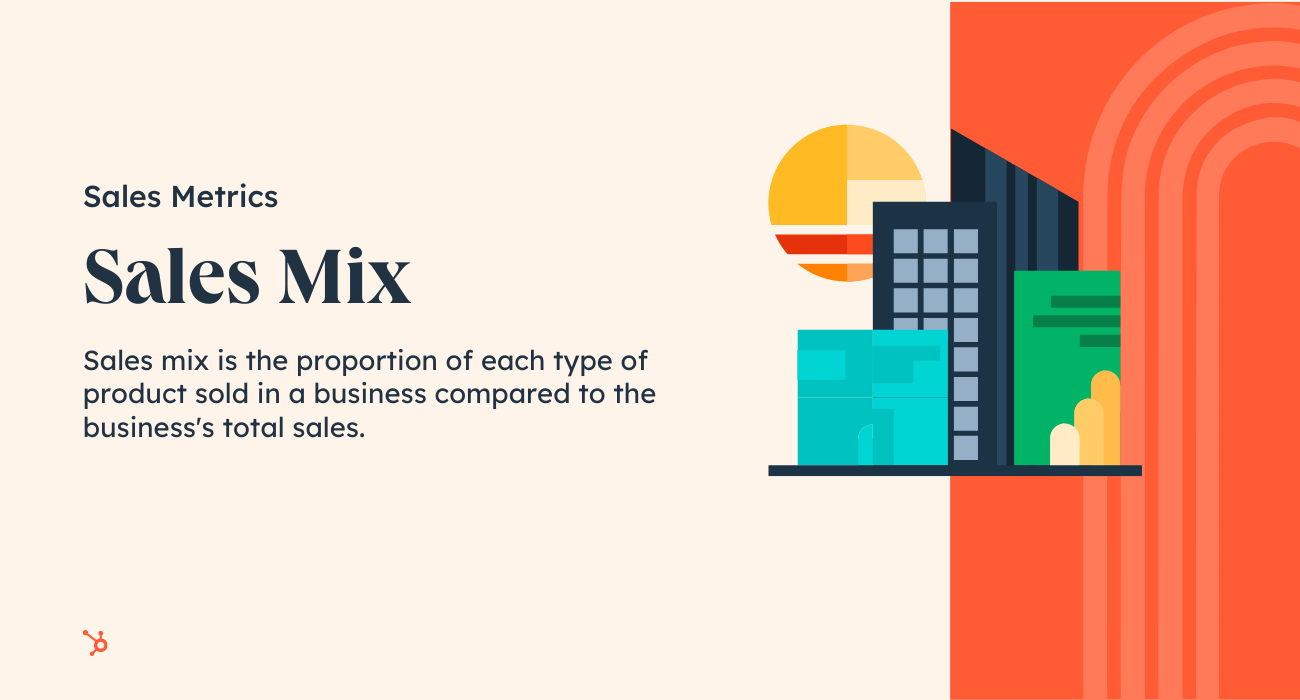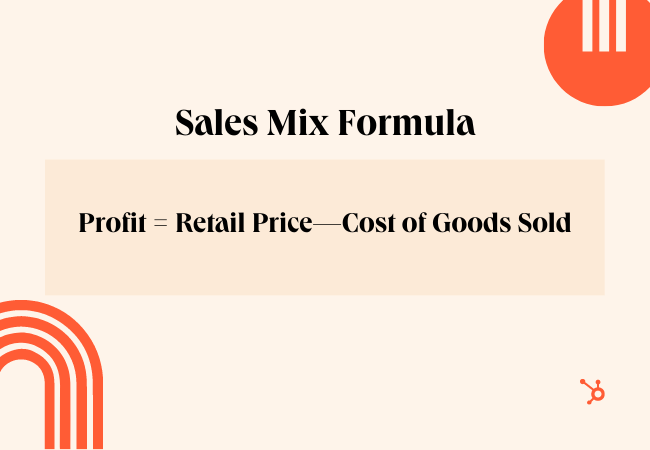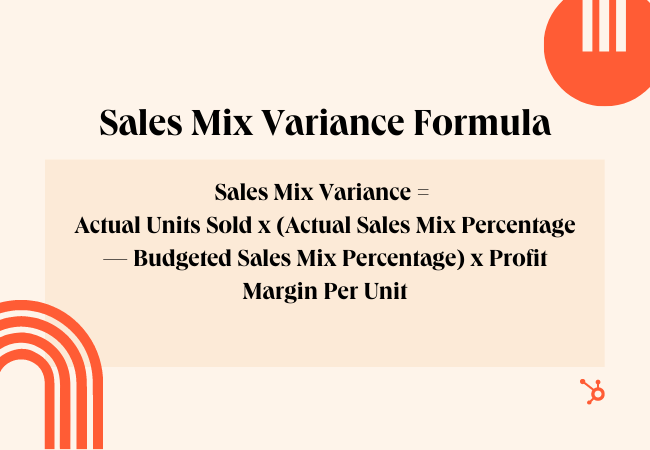In this post, we'll break down what sales mix is, how to calculate it, and some examples of using it to make business decisions.
What is sales mix?
Sales mix is the proportion of each type of product sold in a business compared to the business's total sales. The purpose of calculating sales mix is to understand how the sales of different types of products impact profits.

When you dig into what your company’s sales mix is, you uncover hard data that tells you exactly how much money the sale of each product is contributing to the bottom line. This can not only help you determine how to set future budgets, but it can also provide information about the function, placement, and selling strategies behind each product your company offers.
First, let’s walk through how to calculate the sales mix for your business.
Sales Mix Formula

To calculate sales mix, begin by understanding the profitability of each product your company sells.
Profit = Retail Price—Cost of Goods Sold
Sales Mix Example
To keep things simple, let’s approach this by unit. In this example, your company sells speakers, and you want to compare two of your products—a wired speaker that retails for $35 and a Bluetooth speaker that retails for $65. Let’s walk through how to calculate the sales mix with this information.
Product A
- Retail Price for One Unit — $35
- Cost to Company — $8.75
Profit = $35 — $8.75 = $26.25
Once you have your profit value, it’s time to find the profit margin. Find your profit margin by dividing your profit value by the sale price.
Profit Margin = Profit / Sale Price
Let’s use this equation for our wired speaker example:
Profit Margin = $26.25 / $35 = 75%
This means for every $100 worth of wired speakers your company sells, it results in $75 of profit.
Now, let’s compare this value to the Bluetooth speakers.
Product B
- Retail Price for One Unit — $65
- Cost to Company — $21
Profit = $65 — $21 = $44
Profit Margin = $44/$65 = 67%
This means for every $100 worth of Bluetooth speakers your company sells, it contributes $67 to the bottom line.
Through these calculations, we can see that the more wired speakers you sell, the more profitable your sales mix is. It doesn’t mean your company should discontinue selling Bluetooth speakers, however, it could mean devoting more focus to selling wired speakers could lead to more profit. This could look like allocating more resources to paid advertising for wired speakers or leveraging them as an up-selling opportunity.
Now that you understand what sales mix is, and how to calculate it for the products your company sells, let’s discuss ways your company can make necessary improvements to sales mix to bring in more profits.
To improve your company’s sales mix, you need to understand sales mix variance.
Sales Mix Variance
Sales mix variance explains the difference between the sales mix a company has budgeted for and its actual sales mix. This information helps companies understand how well their products are performing, providing valuable information about the potential profitability of their products.
Chances are, your company has budgeted sales targets for each product that you and your team are working towards. From these budgeted sales targets, your company can estimate what sales mix will be to reach your sales target. At the end of the month or quarter, you can compare the actual sales made and sales mix to what was projected.
Here’s the information you need about each product to calculate the sales mix variance:
- Number of actual units sold
- Actual sales mix percentage: the number of actual units sold of a product divided by total units sold of all products
- Budgeted sales mix percentage: the number of budgeted units sold of a product divided by the budgeted total units sold of all products
- Profit margin per unit (in dollars, not percentages)
Sales Mix Variance Formula

Here’s the formula for sales mix variance:
Sales Mix Variance = Actual Units Sold x (Actual Sales Mix Percentage — Budgeted Sales Mix Percentage) x Profit Margin Per Unit
Now we can apply this formula to our speaker company example.
Sales Mix Variance Examples
Let’s say our speaker company has a goal of selling 750 total units, 500 units of wired speakers, and 250 units of Bluetooth speakers, during a sales period. During this period, the company actually sold 1000 total units, consisting of 700 units of wired speakers and 300 units of Bluetooth speakers.
The actual sales mix percentage for each product is as follows:
- 700 units of wired speakers / 1000 actual total units sold = 70%
- 300 units of Bluetooth speakers / 1000 actual total units sold = 30%
The budgeted sales mix percentage for each product is as follows:
- 500 budgeted units of wired speakers / 750 budgeted total units sold = 66.7%
- 250 budgeted units of Bluetooth speakers / 750 budgeted total units sold = 33.3%
Now let’s calculate the sales mix variance for each product.
Sales Mix Variance for wired speakers = 700 x (70% — 66.7%) x $26.25 = positive variance of $606
Sales Mix Variance for Bluetooth speakers = 300 x (30% — 33.3%) x $14 = unfavorable variance of -$138.6
Through these calculations, we can see the sales of wired speakers had a positive variance, meaning the company made an additional $606 dollars in sales of this product. For the Bluetooth speakers, there was an unfavorable variance, meaning the actual cost to produce and sell the Bluetooth speakers was $138.60 greater than the expected cost.
Use Sales Mix to Maximize Revenue
Understanding the sales mix of your company’s product line is a value-added activity that can shed light on the priorities of your customer and align those with profit and revenue goals for the business. Use the sales mix and sales mix variance formulas to optimize your sales strategy this quarter.
This post was originally published in April 2020 and has been updated for comprehensiveness.
Sales Metrics
.png?width=112&height=112&name=Image%20Hackathon%20%E2%80%93%20Square%20(14).png)





-Nov-05-2025-08-56-33-6007-PM.webp)
![Sales metrics: What to track, how to track, & why [expert tips]](https://53.fs1.hubspotusercontent-na1.net/hubfs/53/Sales-metrics-1-20251030-6874232.webp)




